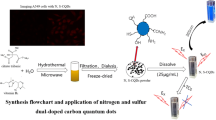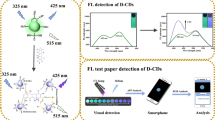Abstract
Amphiphilic blue-fluorescence carbon dots (B-CDs) were synthesized via pyrolysis method with citric acid and oleamine as precursors. B-CDs are monodispersed in ethanol, toluene, and ultrapure water with the average particle sizes of 3.33 nm, 2.05 nm, and 4.12 nm, respectively. The maximum emission wavelength of the B-CDs excitation at 370 nm is located at 459 nm. The B-CDs have good optical properties with excellent photostability. The fluorescence quantum yield (QY) of the as-prepared CDs is as high as 30.17%. The fluorescence of B-CDs is quenched because of static quenching by oxytetracycline. A high selective and sensitive fluorescence probe for detecting oxytetracycline was constructed with a linear range of 1.52–27.60 µg/mL and the detection limit of 0.33 µg/mL. The B-CDs-based fluorescence probe can be applied to analyze oxytetracycline in milk; the recoveries and relative standard are satisfactory. Furthermore, the B-CDs were exploited for imaging of SH-SY5Y cells. The results demonstrate that as-synthesized CDs can serve as a cellular imaging reagent owing to remarkable bioimaging performance. This work provides a new strategy for the detection of oxytetracycline in food.







Similar content being viewed by others
Data availability
The datasets used and/or analyzed during the current study are available from the corresponding author on reasonable request. Correspondence and requests for materials should be addressed to Chuan Dong.
References
Akbarzadeh S, Khajehsharifi H, Hajihosseini S (2022) Detection of oxytetracycline using an electrochemical label-free aptamer-based biosensor. China Biosensors (basel) 12(7):468
Anjana RR, Anjali DJ, Jayasree M, Aparna RS, Aswathy B, Praveen GL, Sony G (2017) S, N-doped carbon dots as a fluorescent probe for bilirubin. Austria Mikrochim Acta 185(1):11
Anju SM, Aswathy AO, Varghese S, Abraham MK, Lekshmi RS, Ibrahim Shkhair A, George S (2023) Folic acid incorporated nitrogen-doped carbon dots as a turn-on fluorescence probe for homocysteine detection, England. Luminescence (chichester, England) 38(1):19–27
Chen HX, Peng JX, Yu L, Chen H, Sun MT, Sun ZL, Ni RY, Alamry KA, Marwani HM, Wang SH (2020) Calcium ions turn on the fluorescence of oxytetracycline for sensitive and selective detection. Am J Fluoresc 30(3):463–470
Gao R, Wu ZB, Wang L, Liu J, Deng YJ, Xiao ZH, Liang YS (2020) Green preparation of fluorescent nitrogen-doped carbon quantum dots for sensitive detection of oxytetracycline in environmental samples. Switzerland Nanomater (basel) 10(8):1561
Jana J, Aditya T, Ganguly M, Pal T (2017) Carbon dot-MnO2 FRET system for fabrication of molecular logic gates, Switzerland. Sens Actuators, B Chem 246:716–725
Javed N, O’Carroll DM (2021) Carbon dots and stability of their optical properties, Germany. Part Part Syst Charact 38(4):2000271
Jin JC, Wang BB, Xu ZQ, He XH, Zou HF, Yang QQ, Jiang FL, Liu Y (2018) A novel method for the detection of silver ions with carbon dots: excellent selectivity, fast response, low detection limit and good applicability, Switzerland. Sens Actuators, B Chem 267:627–635
Liang ZC, Kang M, Payne GF, Wang XH, Sun RC (2016) Probing energy and electron transfer mechanisms in fluorescence quenching of biomass carbon quantum dots. Am ACS App Mater Interfaces 8(27):17478–17488
Liu Y, Sun DM, Zhang ZY, Zhang L, Nie SD, Xiao JP, Liu CY (2020) Amphiphilic carbon dots with excitation-independent double-emissions, Germany. Part Part Syst Charact 37(7):2000146
Liu T, Zhang S, Fan XY, Yang D, Wang M, Shao XD, Wang SH, Yue Q (2022) Inner-filter effect induced fluorescence quenching of carbon dots for Cr(VI) detection with high sensitivity. Am J Fluoresce 32(6):2343–2350
Qin J, Nan Q, Yang J, Yang R (2018) Bright carbon dots via inner filter effect for the sensitive determination of the purine metabolic disorder in human fluids, China. Spectrochim Acta Part A Mol Biomol Spectrosc 203:421–427
Qu RH, Zheng GZ (2020) Determination of oxytetracycline in milk based on carbon quantum dots fluorescence quenching method, China. Guangdong Chem Ind 433(23):128–129
Shi P, Song Y, Tang J, Nie ZF, Chang JW, Chen QY, Wang YF, Guo TT, Zhang J, Wang H (2022) Ultra-narrow bandwidth red-emission carbon quantum dots and their bio-imaging, Netherlands. Physica E 142:115197
Srivastava I, Misra SK, Bangru S, Boateng KA, Soares J, Schwartz-Duval AS, Pan D (2020) Complementary oligonucleotide conjugated multicolor carbon dots for intracellular recognition of biological events, America. ACS Appl Mater Interfaces 12(14):16137–16149
State Standardization Administration of China (2008) Determination of oxytetracycline, tetracycline, chlortetracycline, doxycycline residues in milk and milk power - HPLC-UV method, China. GB/T 22990–2008
Tian M, Liu YM, Wang YT, Zhang Y (2019) Yellow-emitting carbon dots for selective detecting 4-NP in aqueous media and living biological imaging, England. Spectrochim Acta Part A Mol Biomol Spectrosc 220:117117
Varghese M, Balachandran M (2021) Antibacterial efficiency of carbon dots against gram-positive and gram-negative bacteria: a review, Englad. J Environ Chem Eng 9(6):106821
Wang YH, Liu YY, Zhao L, Sun LL, Zhao XH, Xia YZ (2020) κ-Carrageenan-derived carbon dots for highly selective and sensitive detection of Fe3+ and oxytetracycline, America. J Mater Sci 56(2):1272–1285
Wang BG, Zhang LL, Dai SS, Lu HS (2022a) Remarkably boosting the lubricity of polyalphaolefin by loading amphiphilic carbon dots stabilized by Span-80, Netherlands. Diamond Relat Mater 124:108924
Wang Q, Li XC, Yang K, Zhao SJ, Zhu SH, Wang BH, Yi JN, Zhang Y, Song SZ, Lan MH (2022b) Carbon dots and Eu3+ hybrid-based ratiometric fluorescent probe for oxytetracycline detection, America. Ind Eng Chem Res 61(17):5825–5832
Xu XW, Zhang K, Zhao L, Li C, Bu WH, Shen YQ, Gu ZY, Chang B, Zheng CY, Lin CT, Sun HC, Yang B (2016) Aspirin-based carbon dots, a good biocompatibility of material applied for bioimaging and anti-inflammation, America. ACS Appl Mater Interfaces 8(48):32706–32716
Xu ZL, Ye SL, Luo L, Hua XD, Lai JX, Cai XP, Liang QW, Lei HT, Sun YM, Chen YP, Shen X (2020) Fluorescent enzyme-linked immunoassay based on silane-doped carbon dots for sensitive detection of microcystin-LR in water and crucian samples, Netherlands. Sci Total Environ 708:134614
Yadav PK, Singh VK, Kumar C, Chandra S, Jit S, Singh SK, Hasan SH (2019) A facile synthesis of green-blue carbon dots from artocarpus lakoocha seeds and their application for the detection of iron (III) in biological fluids and cellular imaging, Germany. Chem Select 4(42):12252–12259
Yang JC, Gao S, Zhang JH, Lv HT, Wu Q (2022) Ionic liquid and octadecylamine co-derived carbon dots for multi-mode high performance liquid chromatography, Netherlands. Microchem J 182:107932
Yu JK, Yong X, Tang ZY, Yang B, Lu SY (2021) Theoretical understanding of structure-property relationships in luminescence of carbon dots, America. J Phys Chem Lett 12(32):7671–7687
Zeng JJ, Liao LH, Lin X, Liu GY, Luo XG, Luo M, Wu FS (2022) Red-emissive sulfur-doped carbon dots for selective and sensitive detection of mercury (II) ion and glutathione, America. Int J Mol Sci 23(16):9213
Zhang CY, Xie XG, Feng SS, Lei W, Xia MZ, Wang FY, Wang HL (2022) Sensitive fluorescent detection and micromechanism of Mn-doped CuS probe for oxytetracycline hydrochloride, China. Spectrochim Acta Part A Mol Biomol Spectrosc 284:121768
Zhao WS, Li XX, Yang YZ, Yan LP, Liu XG, Wang H, Xu BS, Zha H, Luo Q, Ma CQ (2022) Controllable photoelectric properties of carbon dots and their application in organic solar cells, China. Chin J Polym Sci 40(1):7–20
Zhuo Y, Miao H, Zhong D, Zhu SS, Yang XM (2015) One-step synthesis of high quantum-yield and excitation-independent emission carbon dots for cell imaging, Netherlands. Mater Lett 139:197–200
Zu FL, Yan FY, Bai ZJ, Xu JX, Wang YY, Huang YC, Zhou XG (2017) The quenching of the fluorescence of carbon dots: a review on mechanisms and applications, Austria. Mikrochimica Acta 184(7):1899–1914
Zulfajri M, Gedda G, Chang CJ, Chang YP, Huang GG (2019) Cranberry beans derived carbon dots as a potential fluorescence sensor for selective detection of Fe3+ ions in aqueous solution, America. ACS Omega 4(13):15382–15392
Funding
This study received financial supports from the Shanxi Scholarship Council of China (Nos. 2020–002 and 2021–014).
Author information
Authors and Affiliations
Contributions
Zhenhua Yang and Yuexia Zhang conceptualized the study. Xintong Yang conducted the experiment. Xiaopeng Fan and Yujuan Cao analyzed the data. Zhenhua Yang wrote the original manuscript. Yuexia Zhang, Zhongping Li, and Chuan Dong revised the manuscript. All authors read and approved the manuscript.
Corresponding author
Ethics declarations
Ethical approval
Not applicable.
Consent to participate
Not applicable.
Consent for publication
Not applicable.
Competing interests
The authors declare no competing interests.
Additional information
Responsible Editor: Ester Heath
Publisher's note
Springer Nature remains neutral with regard to jurisdictional claims in published maps and institutional affiliations.
Rights and permissions
Springer Nature or its licensor (e.g. a society or other partner) holds exclusive rights to this article under a publishing agreement with the author(s) or other rightsholder(s); author self-archiving of the accepted manuscript version of this article is solely governed by the terms of such publishing agreement and applicable law.
About this article
Cite this article
Yang, Z., Yang, X., Zhang, Y. et al. Detection of oxytetracycline in milk using a novel carbon dots-based fluorescence probe via facile pyrolysis synthesis. Environ Sci Pollut Res 30, 84002–84010 (2023). https://doi.org/10.1007/s11356-023-28380-5
Received:
Accepted:
Published:
Issue Date:
DOI: https://doi.org/10.1007/s11356-023-28380-5




